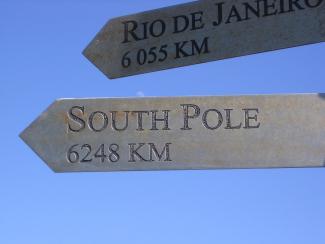“Something Was Messing With the Earth’s Axis. The Answer Has to Do With Us.” I have to take that headline in the New York Times personally, as a potentially responsible party more at fault and liable for damages than most.
“Accelerated melting of the polar ice sheets and mountain glaciers had changed the way mass was distributed around the planet enough to influence its spin,” according to the article. Worse, scientists have now “identified another factor that’s had the same kind of effect: colossal quantities of water pumped out of the ground for crops and households.” We are all part of the problem, of course, but what followed singled me out: “Scientists knew the planet’s centerline could move. But it took a sharp turn sometime around the start of the 2000s.”
You see, I had stood exactly at the Earth’s axis and in fact had been witnessed to give it “a sharp turn.” In fact, it was also exactly at the start of the 2000s. I was visiting the South Pole to celebrate the millennium. It is the only place on Earth where you can select which time zone you want to bring in the new year, and do so in broad daylight. Indeed, all the time zones come together there, and if you want you can celebrate 24 times.

Surprisingly, there are ordinarily three South Poles to pick from, and on New Year’s Eve, when I arrived, for a few hours there are four. All are confusingly within yards of each other and the nearby housing, labs, and offices of the U.S. National Science Foundation.
The least important of the South Poles is the only impressive one. It is a three-foot-tall segment of barbershop-striped cylinder stuck in the ice, topped by one of those mirrored spheres sold as lawn ornaments. At a respectful distance around this odd monolith are flag poles displaying the banners of the principal members of the Antarctic Treaty. The problem is that it isn’t really at the South Pole. Another lies a very short distance away and has a better claim at authenticity. Rather, it’s just the colorful spot you go to for the usual snapshots.
The real South Pole, the spot where all lines of longitude converge, is marked by two sections of pipe sunk in the snowpack about four feet apart. The pair hold a sign commemorating the arrival of the first humans to that spot. The longitudinal confluence lies vaguely between these two pipes. So it’s not a very satisfying marker.
And that lack of precision was not all that was wrong with this alleged South Pole: the Antarctic ice cap, which is 8,000 feet thick at that point, moves laterally by an inch a day. So this marker only lasts a few hours as the legitimate South Pole. And in fact there is an annual tradition to respot the pipes and sign on New Year’s Day.
We had arrived in our little Twin Otter plane eight hours before the millennium. We found a group of technicians using a highly accurate GPS device with a huge parabolic antenna to mark where the South Pole was at exactly that time. When they were done they pushed a foot-long bamboo stick into the snow, with a red ribbon tied to its top. It was indeed a weak reed for such a momentous occasion.
After midnight passed, as technicians moved the metal sign and its two pipes to straddle the bamboo stick, a physicist told me he understood my concern about not finding an accurate and impressive marker for the convergence of longitude. And then he showed me the fourth South Pole—more real than any of the others. It was twenty feet away and consisted of a foot-high tapered metal spike stuck in the snow. It marked the axis of the Earth’s rotation, which no longer coincides with the lines of longitude laid down centuries ago due in part to the wobble resulting from human activities.
I put my hand on the top of the spike and gave it a twist.
This blog originally appeared in The Environmental Forum (Sept/Oct 2023) and is reprinted with permission.
